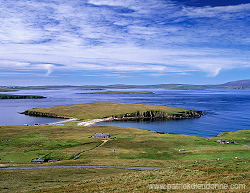| |
As pointed out on the
introduction page, Nynorn is mostly
based on Shetland Norn. This does not mean though that the other dialects, such as West Norn (which differs from Shetland Norn mostly phonetically) and Orkney Norn are
valued any less. If you are up to it, you can use those versions instead and on this page we give you a sketchy insight into what it could look like.
It should also be mentioned that the creation of 'Nynorn dialects' allows us to include those real features of Norn that we have rejected from the main 'dialect' (apart from eventual lexical distinction between Shetland and Orkney). As an example, we can take the case system. Nynorn has 4 cases, which seems to be present in the Shetlandic version of Lord's Prayer and the Ballad of Hildina. On the contrary, the only known specimen of Orkney Norn,
the Orkney Lord's Prayer, shows a reduced number of cases, if any. Most probably, Orkney Norn had 2 cases, common and genitive, like f.ex. in English, Scots and Danish. Someone would even argue that a similar 2-case system, as presented in Orkney
Norn, should be chosen for the 'default' (Shetland) Nynorn instead of the 4-case one. This view can be supported with
plenty of evidence from the
existing Shetland Norn texts (s.
Grammar of Shetland Norn, A.1.1.1.4.), cf. also the mixing of nominative and accusative in the ballad of Hildina (the ballad also features sporadic vacillations between accusative and dative,
accusative and genitive). As a compromise solution, we have chosen the 4-case system for Shetland and Foula/Westside Nynorn and the 2-case system for Orkney Nynorn. The same logic should apply for other dialectal features that cannot be included within the same reconstruction.
Below you will find a list of the main distinctive features of Nynorn dialects with a few 'live' examples (see General for more detailed information on the difference between the three 'real' dialects). This is just a rough sketch and at the moment we have no plans to further develop this section. Of course, if any of our readers come up with new ideas on this matter, we will not object in any respect.
Shetland Nynorn: ON ll,nn > llj,nnj, a > æ before llj,nnj, -in(n) > -en, -i(t),u > -i,u, ON hv > hv, 4 cases system;
West Nynorn: ON ll,nn > dl,dn, -in(n) > -in, -i(t),u > -e,o, ON hv > kv, á > wå, h- is
dropped in pronouns, occasional postvocalic -g inserts, 4 cases
system; several distinctions from Shetland Nynorn: Sh. er, eg, mukkið, lengi - W. jar, jag, megeð, linge;
Orkney Nynorn: ON ll,nn > ll (occasionally llj),nn, ON hv > v,
partial preservation of diphtongs and the ON þ/ð (marked as þ
to distinguish it from the silent ð), 2 cases system (common case
and genitive), weak feminine nouns end at -o.
Shetland Nynorn (default) |
Shetland Mainland Nynorn |
Foula/Westside Nynorn |
Orkney Nynorn |
Old Norse |
English |
Bånnið sat i grasenu. |
Bånnjið sat i grasenu. |
Bjadneð sat i grasino. |
Bannið sat i grasið. |
Barnit sat í grasinu. |
The child sat in the grass. |
| Dokka (stolka) fell i hørug sen stud veð hjogen. |
Dokka (stoljka) fellj i hørug sen stud veð hjogen. |
Dokka (stolka) fedl i hørug sen stug veð hjogin. |
Stjølko fell(j) i høru sin stud viþ houen. |
Stulka (dokka) fell í heyhrúgu sem stóð við hauginn. |
A girl fell into a hey stack which stood near the barrow. |
| Dokken (stolken) hever kallað å hvita hesten. |
Dokken (stoljken) hever kælljað å hvita hesten. |
Dokken (stolken) hever kadlað wå kvita hestin. |
Stjølken hever kall(j)að å vita hesten. |
Stulkan hefir kallat á hvíta hestinn. |
The girl has called (upon) the white horse. |
| Hann glemdi um tegen og hjogen. |
Hænnj glemdi um tegen og hjogen. |
Ann glemde um tegin og hjogin. |
Hann glaimde en taien og houen. |
Hann gleymdi um teiginn ok hauginn. |
He forgot about the field strip and the barrow. |
| Hesten feller ikke, båden er i landi og eg hevi sovið mukkið lengi. |
Hesten felljer ikke, båden er i lænjdi og eg hevi sovið mukkið lengi. |
Hestin fedler ikke, båtin jar i lande og jag heve soveð megeð linge. |
Hesten fell(j)er ikke, båten er i land og eg heve sovið [mikið lenge]. |
Hestrinn fellr ekki, bátrinn er í landi ok ek hefi sofit mikit lengi. |
The horse does not fall, the boat is onshore [in land] and I have slept for a very long time [much long]. |

|
|

